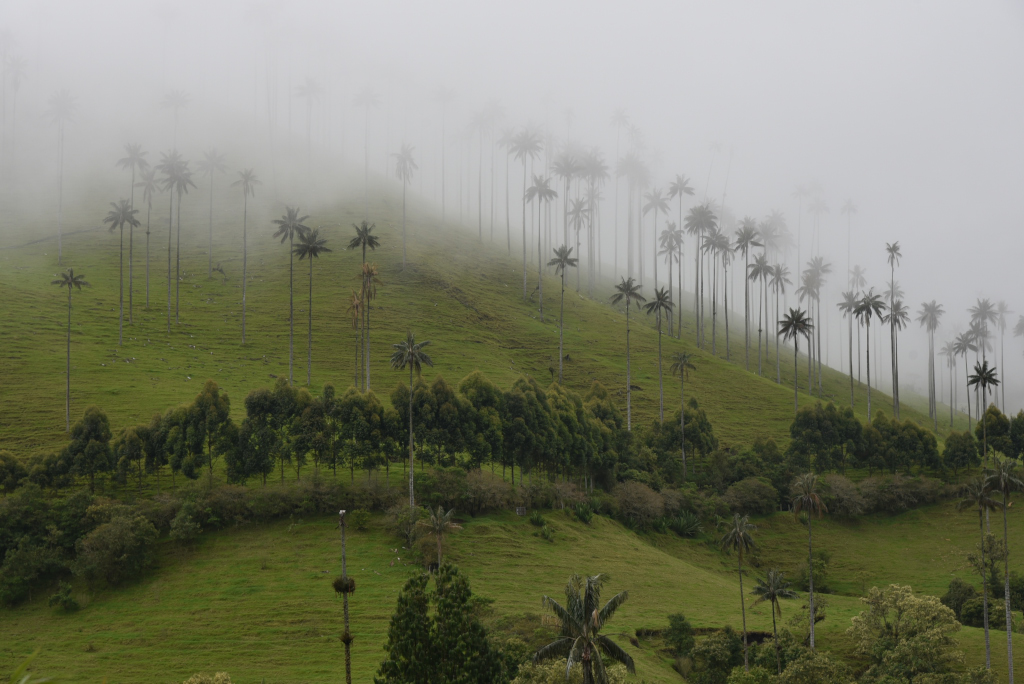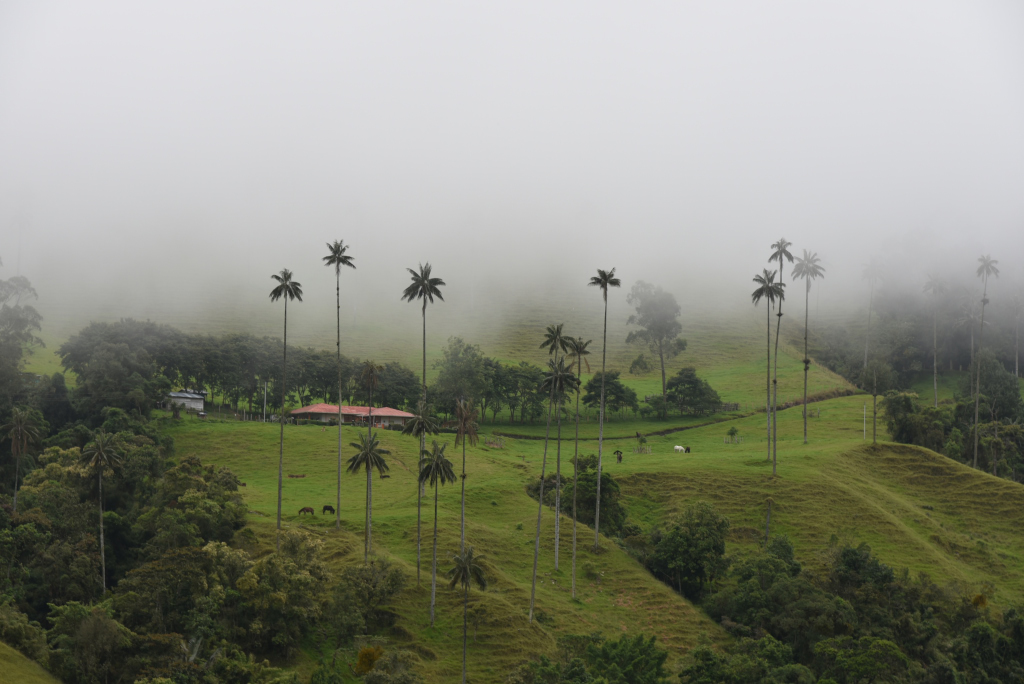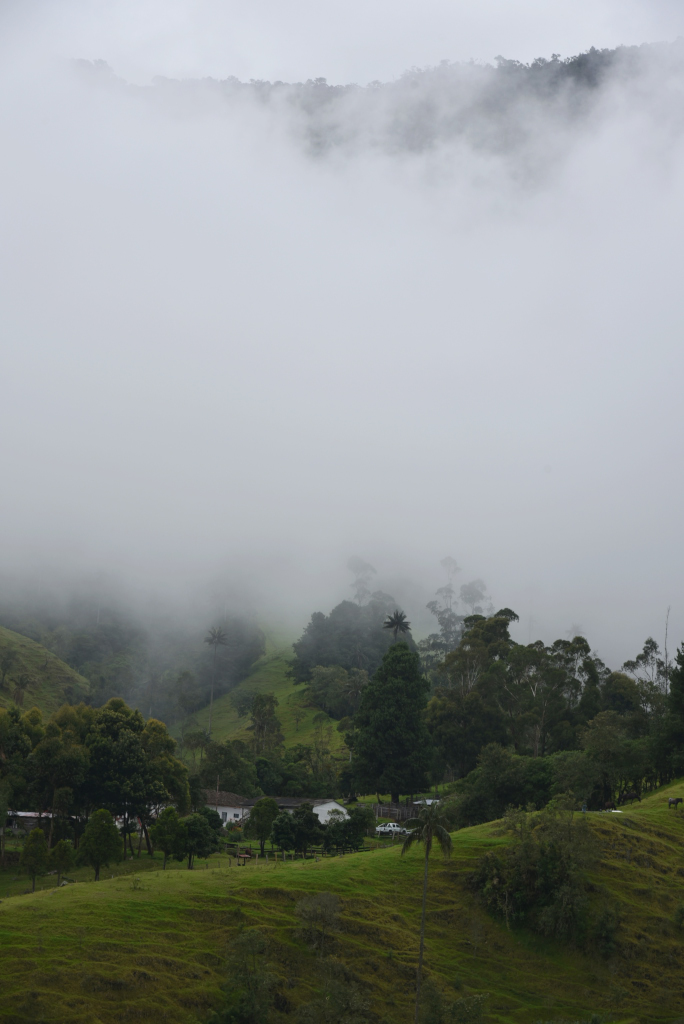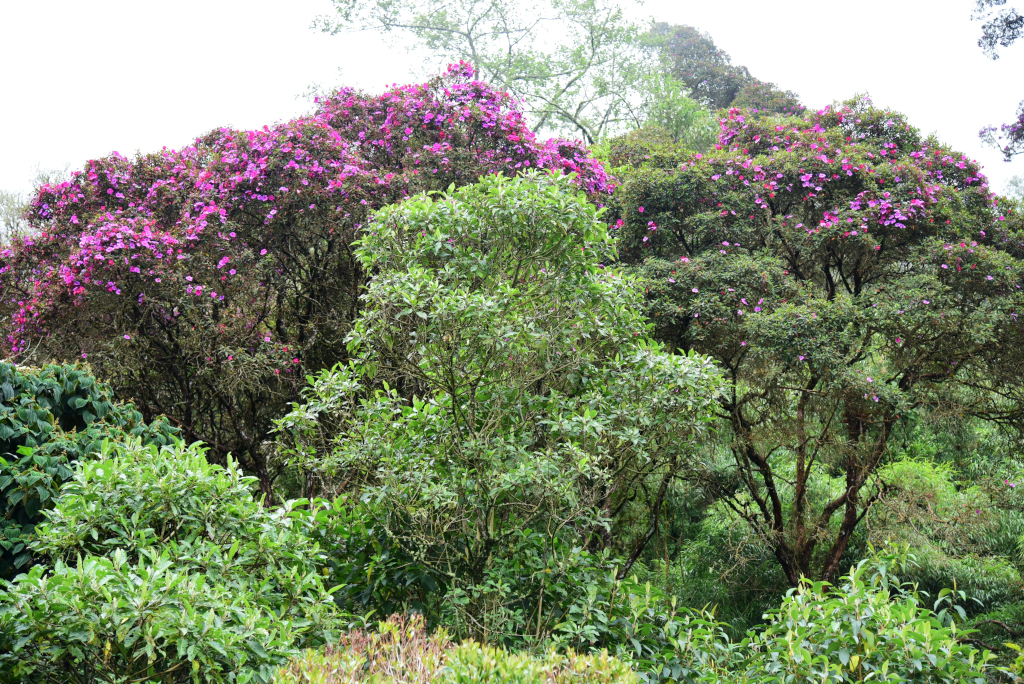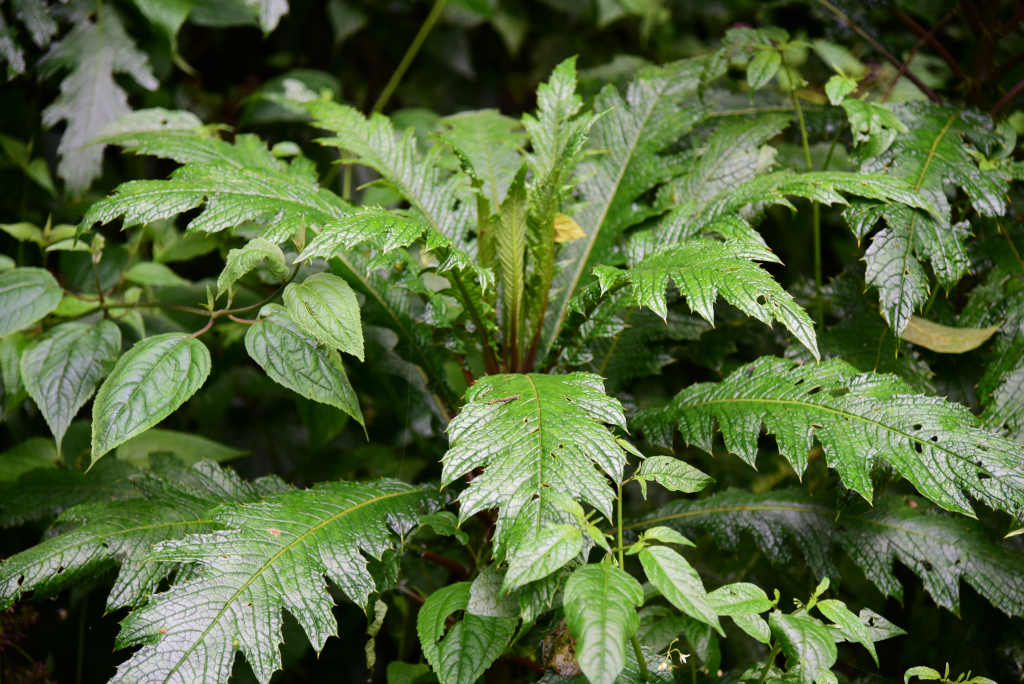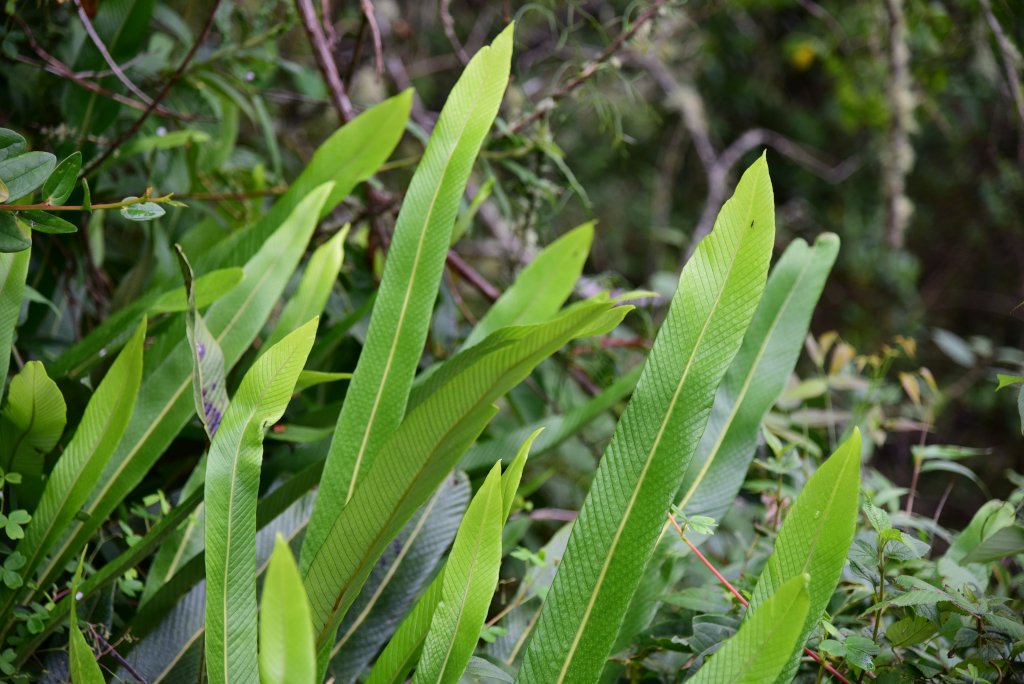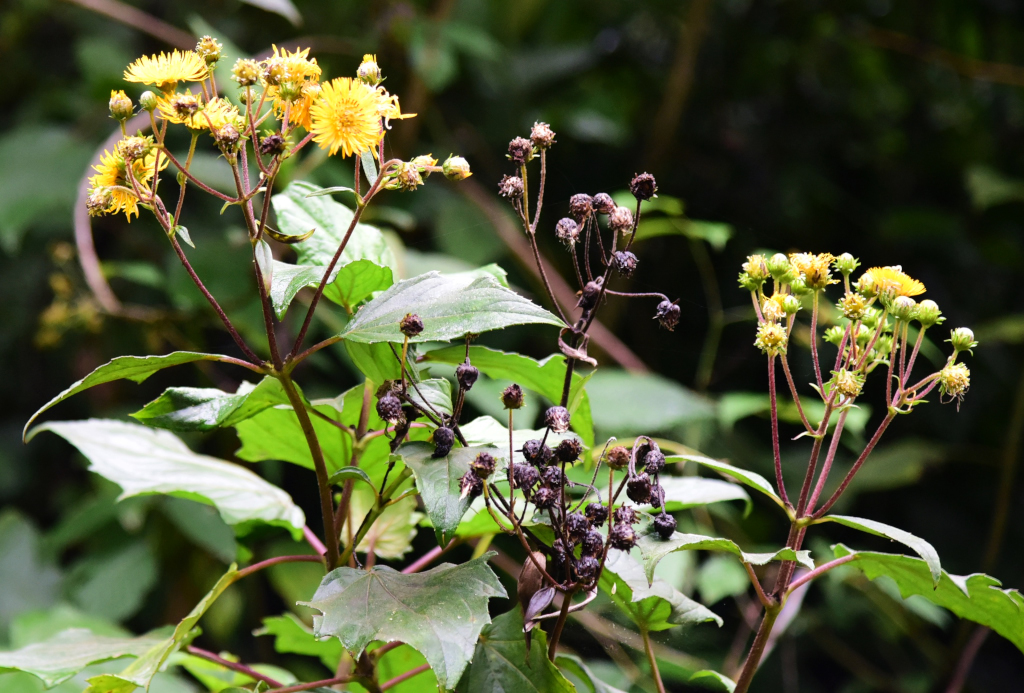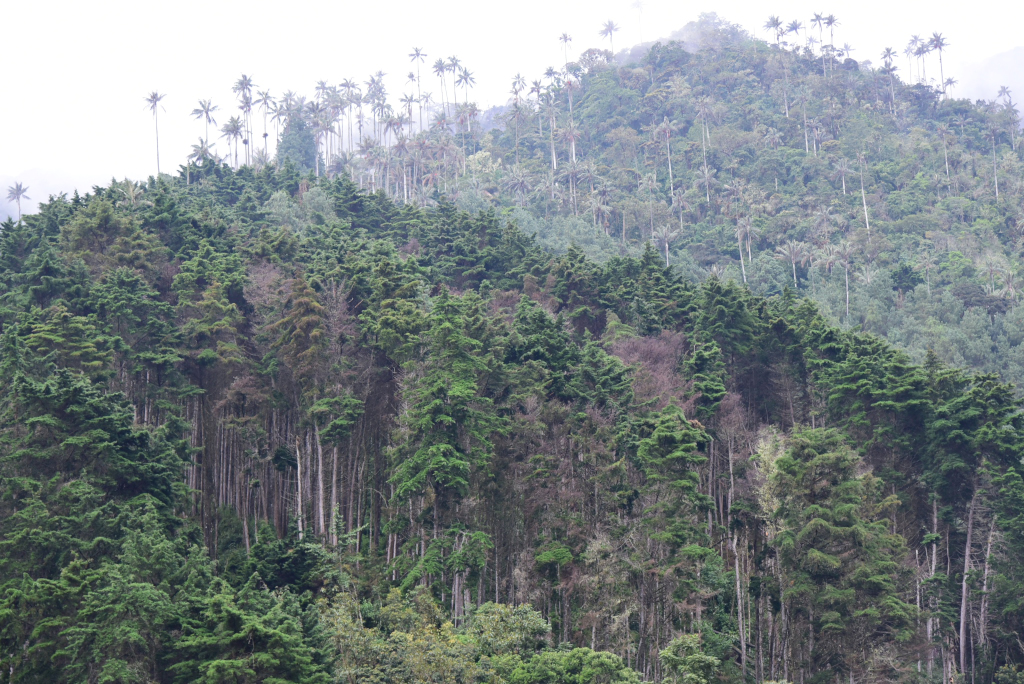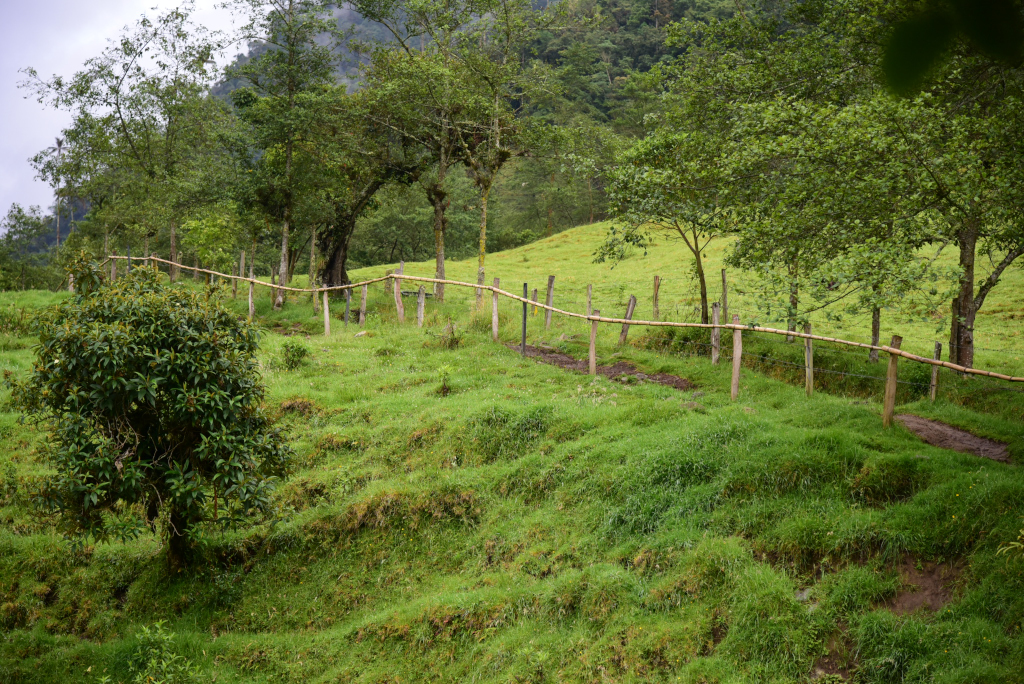April 10, 2018
Waking up in my tranquil enclave far removed from the madding crowd near the plaza of Salento. Despite the occasional sawing some distance from where I lie, there is no other noise, cats meowing, dogs barking, people yelling, or loud engines rumbling. The room may be simple and rustic, but spacious enough, with ample surface areas, adequate lighting, a large bathroom with very hot water, wifi and dependable electricity. In fact, it has occurred to me that this area of Colombia is generally more dependable with respect to these basic services than to the east of the capital, where I began traveling.
In the great hall of the Descanso Y Sazon hotel, where I enjoy a simple but solid breakfast courtesy of the very charming host. Raw wood beams run the length of the hall, naive, large-scale oil paintings adorn the walls, one entire wall glass and overlooking this side of town. I am the only guest here, and the privacy feels luxurious.
Just as I leave for the plaza, a cordon of the Willy’s jeeps passes by the hotel. Despite having arrived at the main plaza around 8:30 am, which is when the Willys are intended to leave for the Cocora valley, I do want to get a coffee. And since we are in coffee country, there should be plentiful cafés serving a strong brew even at this hour of the morning.
Well, not quite. A police officer points me to the well-appointed rustic Café Jesús Martín, which does serve a strong coffee, although with an acidity that makes it far from memorable. I am fortunate to arrive back at the plaza when the last Willy is loading for the valley, apparently waiting for another woman to join. Had I come even 10 minutes later, I may have been left waiting for a considerable amount of time.
Adjoining me at the back of the jeep is a middle-aged Frenchman and his family from Lyon, on a two week visit to Colombia from Lyon. Judging by the places they have chosen to visit, their trip is obviously fairly well-curated, but then they are also engaging in a somewhat risky venture, not having pre-booked any accommodation. And for a family of four, the cost of accommodation alone can be quite high here.
Predictably, I rail about the food, which elicits a knowing chuckle from the man, who happens to be a consultant to vintners in the Rhône valley. And Lyons, where he comes from, is known as the seat of French gastronomy. He rolls his eyes when I tell him that the country needs people like him to introduce wine-making skills. He jokes that perhaps he should retire here with his wife and make that his pet project.
We rise up into the verdant countryside, the green hillsides surging around us as we weave further and further towards the cloud-laden Cocora Valley that represents one of the most popular tourist destinations in Colombia. The family actually came here yesterday for a tour of the coffee fincas, which I won’t have the time to take on. Well, I have done a lot of other things in Colombia, however, so I won’t complain.
At the park entrance, the spectacle that visitors come for surrounds us, the soaring green hills lined with the needle-thin wax palms. The name ‘Cocora’ was the name of a Quimbayan princess, daughter of the local chief Acaime, and means ‘star of water’. The valley is part of the Los Nevados National Natural Park, and is the principal location of the national tree and symbol of Colombia, the Quindío wax palm (taken from Wikipedia).
We decide to not take a guide, as the group has a crude map of the intended hike, and in any case already did a circuit of sorts yesterday on their own. And it turns out that the trail is quite well-marked, except that we begin on the wrong end, wandering straight up the paved road which then arcs up across a hillside, then further into the cloud cover that blankets this lush valley. Around us the palms tower, offering a spectacular sight in this steep, lush valley environment, although the palms are in and of themselves hardly that attractive, just somewhat unusual.
And as we are effectively on private land, part of the area where the palms are growing is actually being planted with avocado seedlings, which may effectively significantly reduce the aesthetic appeal of the palms. At the forest of palms, we pass through a narrow gate onto the grassy field in order to inspect the local set of palms. People are fascinated by the fact that the palms seem hollow, and observing the trunks of some of the collapsed specimens, it seems amazing that such a huge tree could essentially be hollow, the shell of the tree essentially compacted fibre.
The road rises up along the ridge of the hillside, climbing further into the mist, the jungle-coated faces of the adjoining hillsides occasionally revealed through the tendrils of thick fog. The trail is wide enough and follows a relatively even pitch, but progress is slow, what with the astonishing variety of flowering vegetation we pass along, as well as spectacular bird life, as always, difficult to capture photographically.
Plants with leaves that spiral around the stems, or are situated in on the branch in an opposite fashion. Diverse types of ferns with leaves ranging from the delicate to the ponderous. The pinnation of leaves varies wildly, be it conjoined and divided, even, odd or alternating. Tropical cypresses feature soft needles, while most other trees have broad leaves. Vines and orchids abound, although few orchids seem to be flowering: most of the flowers are found on bushes, and often we have to look higher up to locate unique exemplars.
Then there are the flowers, following a wide range of colours, structure, and shapes, the petals and stigma being the most visible part. Delicate mauve flowers, simple and elegant, to clusters of tiny mauve florettes traverse by a band of white. Clusters of slender fluted orange, small, yellow Aster-like flowers, and entire trees overwhelmed by a torrent of purple blossoms. Tiny white flowers hang off the slender branches of another plant, and on another, lengthy red pods hang off of a single strand.
Stunning pink lotus-like flowers cascade from delicate branches, erupting from slender buds. Berries and fruit of varying shapes and sizes abound as well. Then there are pink and reddish ribbed orbs of wild ginger. The trail culminates at a rambling set of bungalows with stunning vistas of the lush mist-enshrouded forest around us, the property surrounded by brilliant orange torch lilies, with manic hummingbirds darting in and out of the bushes.
It seems the family wants to continue directly to the entrance of the park to coordinate a horseback riding session, but considering the direction the weather is heading, and what turns out to be a very arduous riverside leg of the trail back to the entrance, I am not sure how far they will have gotten in the afternoon. Horseback riding in the park is a major attraction for visitors, and would also explain why the trails are in such bad shape. Somehow it seems comical to see Europeans who have probably never gone near a horse trotting by, although I am sure I wouldn’t make much of an impression on a horse either – not that horses hold the remotest interest for me. That is: they are animals that shouldn’t be kept as toys for our whimsy.
The hummingbird house is itself a considerable distance uphill along a narrow trail that weaves through the thick, humid forest. Views occasionally open up of the lush hillsides, but most of the trail is enclosed by the thick vegetation. The sky becomes dark, and the threat of rain imminent. Climbing up to the hummingbird house itself, it turns out that the attraction amounts to no more than a few bird feeders, hardly worth the COP $5,000. But then you get a free beverage, and the coffee they offer is certainly very high quality.
I flirt with the woman at the counter, telling her she must get a of attention with her blue eyes, which of course provokes an even more effusive response regarding my own blue eyes. Facing the feeder and its frenzied population of hummingbirds, I get into a conversation with the son of one of the workers, who comes to visit his mother at work occasionally. It seems remarkable that he would just casually make this lengthy – and very muddy – journey just to hang out here. He is a Social Sciences student in Armenia, but recognizes that his education may not offer any recipe for success here. I point out that it wouldn’t be much different where I live. It is nice to engage in an interesting conversation with a local, rather than simply hanging out with tourists, not that the travelers here are of the most superficial sort.
The young Bavarian hipster couple takes my ridiculous spins on their culture in stride as we navigate the wet muddy path along the churning river to the encruce, and then I am on my own again, attempting to navigate over the rocks protruding from the flowing water, bracing myself along the edges of the muddy mess of the trail where there is some semblance of firm ground. Every step along the trail represents an attempt to keep my shoes dry, which seems almost hopeless, given the soggy mess I find myself in.
I am joined by a trio of young women from Paris, who seem to have an even harder time clambering down the muddy, rocky trail, progress continually hampered by lack of dry ground, and the need to test the stability of stepping stones. One wrong move or slip, and there goes your ankle! At this time of the afternoon, there seem to be no further hikers on the trail, the light is dimming considerably, although it can’t be that late in the afternoon, either.
The denseness of the bush limits the available light considerably, and there seems to be little point to taking photos of anything, other than of the gushing Cocora river the trail follows downhill. The trail is marked by numerous bridges made of haphazardly joined planks tied together with cabling, and linked to parallel cables above for stability, although some of these bridges sway considerable.
On one hand, they are hardly that far away from the relatively shallow channel, but the water churns aggressively, and suddenly falling into the river could cause some unfortunate breakage, never mind getting soaked.
If there is one upside to this messy, cumbersome trail, it seems that leeches are not an issue here – thank God!
It would seem that the final stretch of the trail should be the easiest, but it is the hardest. The trail reaches a clearing, signalling a relatively level continuation across grassy fields, the tall green hills coated with thick forest and lines of the tall wax palms the area is famous for. The green is occasionally interrupted by trees with crowns stained with brilliant purple flowers. The sky above is beginning to clear, but the ground below deep in mud. There are two trails, one wider and seemingly rougher and rockier, and the second narrower and more navigable.
And yet while the former is more difficult to walk on, the second one degrades into deep mud, the danger being that slipping in the mud will cause a person to hurtle into the bordering barbed wire fence, which just seems ludicrous. While we are not paying a lot for admission to this albeit private property, the substantial amounts of money that come into Salento should be invested in cleaning this mess up. And the trail continues for some distance in this manner, easily a kilometre or two, until we finally reach the parking area. It also seems difficult to believe that the total circuit I completed should only take five hours. Perhaps – if one never stopped to look at the stunning scenery …
It would be so easy to just stay in my hotel room, but I should really clean myself up, then visit the town again in the evening prior to ending the day. After all, Salento does have a lot of charm, of which I experienced very little on the first evening here, consumed by the arduous search for accommodation. Very happily, my running shoes did not get wet inside, which is almost impossible to believe. Nothing could make me happier!
Next door, the ramshackle gym/Alcoholics Anonymous outlet will have to wait. There are promising coffee shops on Carrera 6 running out from the Plaza de Bolivar, but mostly closed. Hip youth hang out on the street, smoking, somewhat of an unusual sight in Colombia, and the few artisanry shops I pass by seem to feature some very eye-catching work, far beyond the quality that I was apprised of the places I have traveled heretofore in the country.
The intimate but fashionable Café La Postré offers rich cakes and strong coffees in two small, brightly-lit cubicles. I position myself at one of the small tables and take notes of the day’s adventures, then continue on the search for a place to eat, the town far too dedicated to tipico food to be very appealing. I am seriously considering arepas, a bit of Stockholm syndrome on my part, but then decide on a lasagna across the street as compromise. And one last walk down the tranquil nocturnal streets of Salento to my shuttered hotel, the only activity some hysterical dogs chasing after me and a few souls still in the gym, waving to me as I pass by.













